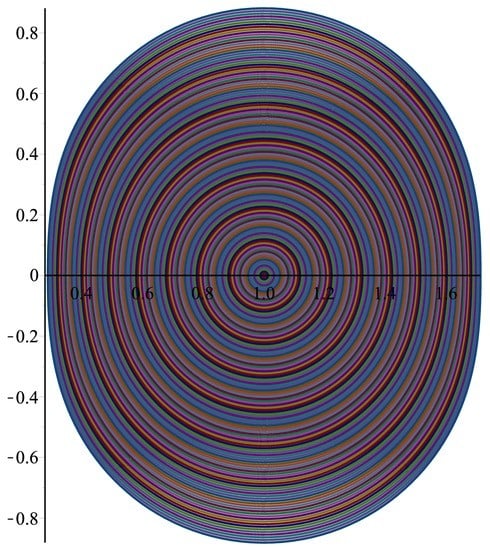Subordination Implications and Coefficient Estimates for Subclasses of Starlike Functions
Abstract
:1. Introduction
2. Subordination Implications
3. The Classes and
4. Coefficient Estimates
5. Conclusions
Author Contributions
Funding
Acknowledgments
Conflicts of Interest
References
- Ma, W.C.; Minda, D. A unified treatment of some special classes of univalent functions. In Proceedings of the Conference on Complex Analysis, Tianjin, China, 19–23 June 1992; Internat Press: Cambridge, MA, USA, 1992; pp. 157–169. [Google Scholar]
- Sokół, J.; Stankiewicz, J. Radius of convexity of some subclasses of strongly starlike functions. Zesz. Nauk. Politech. Rzesz. Mat. 1996, 19, 101–105. [Google Scholar]
- Sokół, J. On some subclass of strongly starlike functions. Demonstr. Math. 1998, 21, 81–86. [Google Scholar]
- Cho, N.E.; Kumar, V.; Kumar, S.S.; Ravichandran, V. Radius problems for starlike functions associated with the sine function. Bull. Iranian Math. Soc. 2019, 45, 1–20. [Google Scholar] [CrossRef]
- Raina, R.K.; Sokół, J. Some properties related to a certain class of starlike functions. C. R. Acad. Sci. Paris 2015, 353, 973–978. [Google Scholar] [CrossRef]
- Kanas, S.; Masih, V.S.; Ebadian, A. Relations of a planar domains bounded by hyperbolas with families of holomorphic functions. J. Inequal. Appl. 2019, 2019, 246. [Google Scholar] [CrossRef] [Green Version]
- Alimohammadi, D.; Cho, N.E.; Adegani, E.A.; Motamednezhad, A. Argument and coefficient estimates for certain analytic functions. Mathematics 2020, 8, 88. [Google Scholar] [CrossRef] [Green Version]
- Ebadian, A.; Bulboacă, T.; Cho, N.E.; Adegani, E.A. Coefficient bounds and differential subordinations for analytic functions associated with starlike functions. Rev. R. Acad. Cienc. Exactas Fís. Nat. Ser. A Mat. 2020, 114, 128. [Google Scholar] [CrossRef]
- Srivastava, H.M. Operators of basic (or q-) calculus and fractional q-calculus and their applications in geometric function theory of complex analysis. Iran J. Sci. Technol. Trans. Sci. 2020, 44, 327–344. [Google Scholar] [CrossRef]
- Srivastava, H.M.; Bilal, K.H.A.N.; Nazar, K.H.A.N.; Ahmad, Q.Z. Coefficient inequalities for q-starlike functions associated with the Janowski functions. Hokkaido Math. J. 2019, 48, 407–425. [Google Scholar] [CrossRef]
- Srivastava, H.M.; Tahir, M.; Khan, B.; Ahmad, Q.Z.; Khan, N. Some general families of q-starlike functions associated with the Janowski functions. Filomat 2019, 33, 2613–2626. [Google Scholar] [CrossRef]
- Srivastava, H.M.; Tahir, M.; Khan, B.; Ahmad, Q.Z.; Khan, N. Some general classes of q-starlike functions associated with the Janowski functions. Symmetry 2019, 11, 292. [Google Scholar] [CrossRef] [Green Version]
- Ebadian, A.; Cho, N.E.; Adegani, E.A.; Bulut, S.; Bulboacă, T. Radii problems for some classes of analytic functions associated with Legendre polynomials of odd degree. J. Inequal. Appl. 2020, 2020, 178. [Google Scholar] [CrossRef]
- Milovanović, G.V.; Rassias, M.T. (Eds.) Analytic Number Theory, Approximation Theory and Special Functions-In Honor of Hari M. Srivastava; Springer: Berlin/Heidelberg, Germany, 2014. [Google Scholar]
- Murugusundaramoorthy, G.; Magesh, N. Starlike and convex functions of complex order involving the Dziok-Srivastava operator. Integr. Transform. Spec. Funct. 2007, 18, 419–425. [Google Scholar] [CrossRef]
- Ponnusamy, S. Close-to-convexity properties of Gaussian hypergeometric functions. J. Comput. Appl. Math. 1997, 88, 327–337. [Google Scholar] [CrossRef] [Green Version]
- Srivastava, H.M.; Aouf, M.K.; Mostafa, A.O. Some properties of analytic functions associate with fractional-calculus operators. Miskolc Math. Notes 2019, 20, 1245–1260. [Google Scholar] [CrossRef]
- Ali, R.M.; Ravichandran, V.; Lee, S.K. Subclasses of multivalent starlike and convex functions. Bull. Belg. Math. Soc. Simon Stevin 2009, 16, 385–394. [Google Scholar] [CrossRef]
- Kargar, R.; Ebadian, A.; Sokół, J. Radius problems for some subclasses of analytic functions. Complex Anal. Oper. Theory 2017, 11, 1639–1649. [Google Scholar] [CrossRef]
- Sun, Y.; Wang, Z.-G.; Rasila, A.; Sokół, J. On a subclass of starlike functions associated with a vertical strip domain. J. Ineq. Appl. 2019, 2019, 35. [Google Scholar] [CrossRef] [Green Version]
- Yanga, D.-G.; Liu, J.-L. Argument inequalities for certain analytic functions. Math. Comput. Model. 2010, 52, 1812–1821. [Google Scholar] [CrossRef]
- Kargar, R.; Sokół, J.; Mahzoon, H. Some properties of a certain subclass of strongly starlike functions. arXiv 2018, arXiv:1811.01271. [Google Scholar]
- Duren, P.L. Univalent Functions. Grundlehren der Mathematischen Wissenschaften; Springer: Berlin/Heidelberg, Germany, 1983; Volume 259. [Google Scholar]
- Ruscheweyh, S. A subordination theorem for Φ-like functions. J. London Math. Soc. 1976, 13, 275–280. [Google Scholar] [CrossRef]
- Adegani, E.A.; Cho, N.E.; Jafari, M. Logarithmic coefficients for univalent functions defined by subordination. Mathematics 2019, 7, 408. [Google Scholar] [CrossRef] [Green Version]
- Piejko, K.; Sokół, J. Hadamard product of analytic functions and some special regions and curves. J. Inequal. Appl. 2013, 2013, 420. [Google Scholar] [CrossRef] [Green Version]
- Kargar, R.; Ebadian, A.; Sokół, J. On Booth lemniscate and starlike functions. Anal. Math. Phys. 2019, 9, 143–154. [Google Scholar] [CrossRef]
- Kuroki, K.; Owa, S. Notes on new class for certain analytic functions. RIMS Kokyuroku 2011, 1772, 21–25. [Google Scholar]
- Sun, Y.; Jiang, Y.-P.; Rasila, A.; Srivastava, H.M. Integral representations and coefficient estimates for a subclass of meromorphic starlike functions. Complex Anal. Oper. Theory 2017, 11, 1–19. [Google Scholar] [CrossRef]
- Xu, Q.H.; Gui, Y.C.; Srivastava, H.M. Coefficient estimates for certain subclasses of analytic functions of complex order. Taiwan. J. Math. 2011, 15, 2377–2386. [Google Scholar] [CrossRef]
- Sim, Y.J.; Kwon, O.S. Certain subclasses of meromorphically bi-univalent functions. Bull. Malays. Math. Sci. Soc. 2017, 40, 841–855. [Google Scholar] [CrossRef]

© 2020 by the authors. Licensee MDPI, Basel, Switzerland. This article is an open access article distributed under the terms and conditions of the Creative Commons Attribution (CC BY) license (http://creativecommons.org/licenses/by/4.0/).
Share and Cite
Cho, N.E.; Ebadian, A.; Bulut, S.; Analouei Adegani, E. Subordination Implications and Coefficient Estimates for Subclasses of Starlike Functions. Mathematics 2020, 8, 1150. https://doi.org/10.3390/math8071150
Cho NE, Ebadian A, Bulut S, Analouei Adegani E. Subordination Implications and Coefficient Estimates for Subclasses of Starlike Functions. Mathematics. 2020; 8(7):1150. https://doi.org/10.3390/math8071150
Chicago/Turabian StyleCho, Nak Eun, Ali Ebadian, Serap Bulut, and Ebrahim Analouei Adegani. 2020. "Subordination Implications and Coefficient Estimates for Subclasses of Starlike Functions" Mathematics 8, no. 7: 1150. https://doi.org/10.3390/math8071150
APA StyleCho, N. E., Ebadian, A., Bulut, S., & Analouei Adegani, E. (2020). Subordination Implications and Coefficient Estimates for Subclasses of Starlike Functions. Mathematics, 8(7), 1150. https://doi.org/10.3390/math8071150





